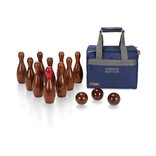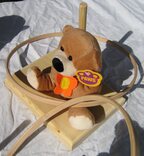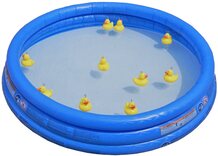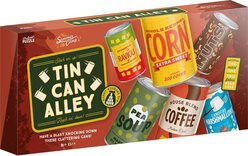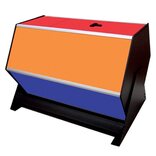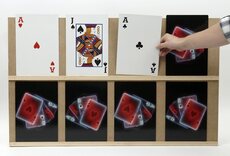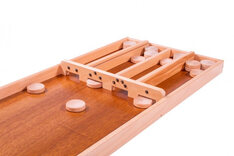The Rules of Skittles or Nine Pins
The first rules given below are based on West Country Skittles, the most commonly played skittles game in England today. Following, this is Long Alley as played in Leicestershire with the version from Derbyshire and Nottinghamshire given as a variant. Being a traditional pub game without any national governing body, variations of equipment and rules abound. Where there is doubt, locally played rules should always apply. For skittles this is especially true with differences in rules, skittle size, number and size of balls, use of a kingpin (a single slightly larger skittle) and dimensions of the alley. These rules merely give a typical example of the regulations laid down by skittles leagues across England rather than being taken from one particular place. Note: 1 yard = 3 feet = 36 inches = 0.9144 metres.
See also: Skittle Games.
West Country Skittles
Description
The nine wooden skittles are ten inches high and shaped like a stunted cigar, with the diameter in the middle being typically 4.5 inches and the diameter at the ends about 3 inches. Balls are traditionally made from heavy wood (nowadays rubber or resin) and any size greater than a tennis ball and less than a cannonball can be used (five inches diameter should be about right). A full size Skittles alley is usually around six feet wide and normally made of wood although other surfaces can be used. The distance from the throwing line to the front skittle is not usually less than 24 feet but in some areas can be significantly more than 30 feet. Sometimes one of the pins, known as a kingpin, is slightly larger than the others - it's position would normally be in the middle or at the front.
Play
The nine skittles are arranged in a square at the end of an alley so that the sides of the square are diagonal to the edges of the alley. A typical square size would be 28 inches from the middle of the front skittle to the middle of the rear skittle. Each turn starts with all the skittles standing and consists of three throws down the alley. The ball must be rolled the length of the alley and not thrown. If the first or second throw is a "sticker" wherein no skittles are left standing, they are all reset. So the maximum score in one turn is twenty seven. In areas where a kingpin is used, the rules vary but the general tendency is not to score a throw until the kingpin is toppled. So it would be theoretically possible to knock down the other 8 skittles with three balls and score no points. Normally the game is played by two teams who play a series of legs. In a leg, each player is allowed one turn of three balls. The total number of points scored by each member of the team are added up and the team with the highest score wins the leg. In some areas, the team who manages to win five legs first wins the match. There are no standard rules for singles. Masters Games suggests that singles are scored in the same way but the first player to win eleven legs wins the game. Alternatively, two players could play first to one hundred and one.
Long Alley
Description
In this Skittles game, popular in the East Midlands, the Alley measures 33 - 36 feet long and 6 feet wide. The Alley is in two parts, though - the first 25 feet or so from the bowlers mark can be cobbles or any other rough ground because the ball or cheese never strikes this surface. The remainder of the alley should be flat and smooth - materials might be hardwood or slate. Behind the skittles, walls and possibly a trough may exist to prevent the skittles straying too far. The pins are larger and thinner than the West Country variety, being 13 - 14 inches high, although the shape is similar - thinner at either end than the middle. They are made from oak or other hardwood and often have iron bands at either end for increased strength. One skittle is taller than the others - this is usually achieved by the addition of a round bobble on the top of an ordinary pin. The resulting shape is similar to the 10 Pin Bowling skittle and gives it a 2 inch height advantage. The pins are set about 20 inches apart with the larger "kingpin" usually being positioned at the front of the set of nine. The projectiles used in the game are known as "cheeses" and are unusually shaped. Each is an oval-ended hardwood log weighing 3 - 4 pounds shaped like a capsule. The strange shape of the cheeses is seen by the beginner as a difficulty to be overcome but seasoned players actually use the eccentric shape to their advantage:- a properly thrown cheese can be made to deliberately break left or right as it bounces and thus achieve angles that would not be possible with a ball.
Play
A turn consists of three attempts to throw a cheese at the skittles. The thrown cheese must bounce just once in the area beyond the line that divides the alley in two before striking the skittles. At the beginning of the turn, the all pins are returned to their starting position and if all the pins are knocked over after the first or second throws, they are also returned to the starting position. Therefore, the maximum score in one turn is 27 points. Throws do not score until the kingpin is toppled. So if the first two throws have knocked over six of the ordinary skittles and the final throw knocks over the kingpin and the final two skittles, the score for the turn is 3 points. Toppled pins remain where they lie between the throws of a turn (unless all the pins are knocked down). The only exception to this is when a pin is knocked onto a side wall, rear wall or other obstacle and bounces back amongst the pins. In this case, the pin that ricocheted back is removed as are any toppled pins that the ricocheting pin disturbs. Any standing pins that are struck by a rogue pin in this fashion, however, are re-erected before the next throw. In the situation where a cheese bounces off a side or back wall and thereafter strikes a pin, any skittles knocked over after the cheese hit the wall are reset and do not score. Similarly, if the cheese does not bounce just once before striking the pins or if the cheese bounces before the rear part of the alley, the cheese does not count and any pins knocked over by it are reset. A typical game to play would be a series of 5 legs, each of which consists of one turn by each player. The highest score each leg wins the leg and the player who wins the most legs wins the match.
Variation
Slightly further North, in Derbyshire and Nottinghamshire, a different version of Long Alley is common. The game is played in just the same way but instead of cheeses, roughly hewn applewood balls are used. A footprint is inscribed at the front of the alley - the front foot must be in the footprint when each ball is thrown. Furthermore, a strip of tin or steel known as "the tin" lies across the alley, one yard ahead of the front pin. The ball must bounce beyond this line or the throw doesn't count, the clang of the tin making it obvious when the line is struck.
Killer
Another game that can be played with any form of nine pins is 'killer', a cousin of the game of 'Killer' played on a dart board and also of Life-Pool played on a snooker table. It is great for large groups as any number can play. To prepare, each player is given a set number of lives (usually 3 or 5) and an order of play is decided - who goes first, second and so on. Normally, each player contributes a small stake to a pot of money. The first player throws 'bad-handed' (right-handed players play left-handed and vice-versa) to set a score to be aimed at. The second player must beat that score or lose a life. Each subsequent player must beat the previous player's score or lose a life. When a player loses his last life he is out of the game. The last player left in the game wins and collects the pot.
These rules are provided by Masters Traditional Games, an Internet shop selling quality traditional games, pub games and unusual games. For general information or for copying and copyright, see our Rules Information page.
Our rules are comprehensive instructions for friendly play. If in doubt, always abide by locally-played or house rules.
Copyright James Masters, 2025. All rights reserved.




